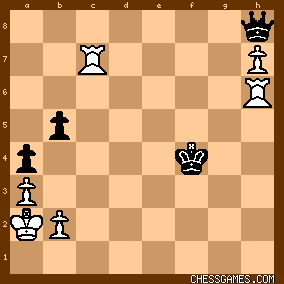| Apr-29-05 | | Runemaster: A classic 2R v Q battle, not surprisingly handled superbly by Alekhine. The many technical difficulties are overcome by clever tactics. First off, I think it is instructive (as is often the case with endgames of the great players) how A. lets some pawns go (such as e4 and c4 on moves 27 and 28) in the interests of concentrating on what's really important in the position - white's 'h' pawn, assisted by the 'g' pawn. I suppose the principle is similar to that in a pure Q ending - given how powerful the queen is, the speed of passed pawns is more important than the number of them. Here, the 'h' pawn ties down the black Q, so while one of the rooks supports the pawn, the other is free to invade the black position. |
|
| Apr-29-05 | | Runemaster: 32.Rde1 stops the BK from coming to the K-side to help the Q. 35.Re6! sets up 36.g5, pulling the BQ out of its blockading position. All the way through, of course, Alekhine avoids the greatest danger in these types of positions, that of losing a rook to a Q-fork. 52.Rh4+ stops the BQ checking on c4 once the 'h' pawn queens. Overall, the ending is an important illustration of one aspect of the 2R v Q debate - it might be easier to handle the queen than the rooks, but if the rooks have a passed pawn that can tie down the queen, they can overrun the enemy position. It helps if you are Alekhine, too, of course. |
|
| Dec-29-06 | | Hidden Skillz: i've seen this game few years ago, and it struck me how alekhine could outplay what it seemed a good defense by black |
|
| Apr-21-10 | | krippp: Doesn't <51.Rc8??> lose the win? After <51..Qxc8 52.Rh4+ Kf3!> Black ought to have a perpetual, for the Black King now supports the vitally important e3-square: <53.h8=Q Qe6+
54.Kb1 Qe1+
55.Kc2 Qf2+
56.Kc3 Qc5+
57.Kd3 Qe3+>, perpetual check. |
|
| May-15-10 | | moonrain: Indeed. At first glance the only check is
on c4. That's why Rh4+. So did not Alekhin himself see Qe6+..? |
|
| Jul-12-13 | | marljivi: Actually,I'm afraid that chessgames.com wrongly entered this game,and that Lilienthal was white and he actually beat Alekhine this way. |
|
Jul-12-13
 | | Phony Benoni: <krippo> You're right; at White's 51st move:
click for larger view<51.Rc8> throws away the win after <51...Qxc8 52.Rh4+ Kf3! 53.h8Q Qe6+>. I don't know who discovered this first; it seems to have escaped contemporary notice. I do have a collection of Alekhine's games from around 2000 that mentions it. Just to ally <marljivi>'s fears, the facts are as presented here. The score is correct, Alekhine was White and he won the game. As for what White should have played, there are various suggestions, complicated and otherwise. Fred Reinfeld, annotating the game in "Chess Review" for January 1934, recommended as simpler "51.Rf7+ Kg5 52.Rh1, followed by 53.Rf8". To my mind, the immediate 51.Rh1, eliminating any and all possibilities of a perpetual check, seems simplest of all. |
|
May-28-16
 | | dernier loup de T: Thanks, Phony Benoni! |
|
|
|
|





